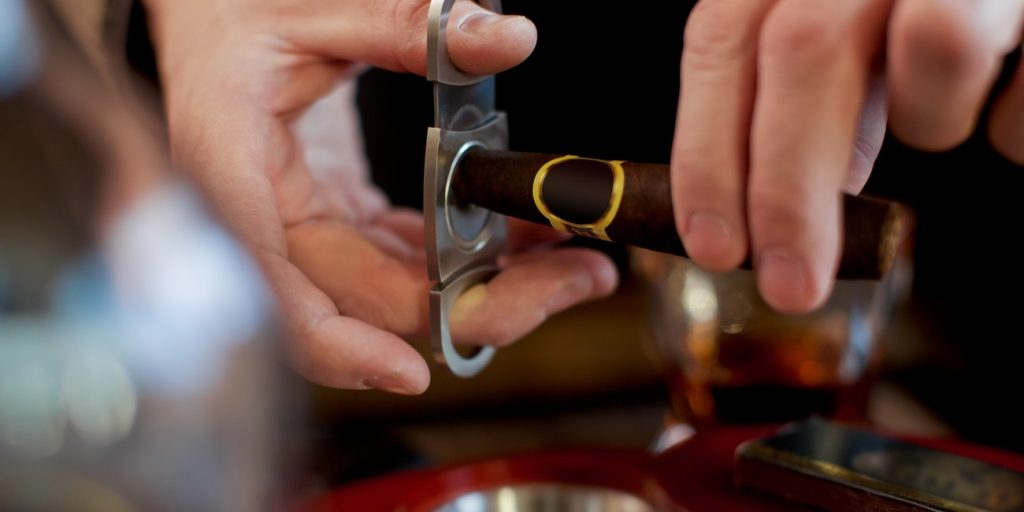Whether you’re an experienced smoker or a novice, understanding the anatomy of a cigar cutter is essential if you want to get the perfect cut and ensure that your cigar is ready for its ultimate smoking experience. In this article, we’ll break down the parts and functionality of a cigar cutter – so find out all you need to know here!

The Basic Parts of a Cigar Cutter
A cigar cutter is a small tool used to cut the end off a cigar so it can be smoked. There are many different cigar cutters, but they all have the same essential parts. The blade is part of the cutter that does the cutting. It is usually made of stainless steel or another type of metal known for its sharpness. The edge is generally hidden inside the cutter’s body until needed.
The handle is part of the cutter you hold onto while using. Therefore, it is essential to have a good grip on the handle to control the edge and make precise cuts. The handle also needs to be strong enough to withstand repeated use. The trigger is part of the cutter that releases the blade when it is time to cut the cigar. Therefore, the trigger must be easy to press quickly and remove the edge when necessary. Some triggers also have a lock so that you can keep the edge from being released accidentally.
Understanding the Blade
A cigar cutter is a tool used to cut cigars. There are many different types of cigar cutters, but they all have one thing in common: a blade. The blade is an essential part of the cutter, and it is what does the actual cutting. Cigar blades come in many different shapes and sizes. The most common form is a straight blade, but there are also curved and serrated blades. The blade size will vary depending on the type of cutter and the size of the cigar being cut.
The blade is usually made from stainless steel or carbon steel. Stainless steel is more expensive but holds its edge better and is less likely to rust. Carbon steel is less costly, but it can rust if it’s not properly cared for.
When choosing a cigar cutter, it’s crucial to find one that feels comfortable in your hand and has a sharp blade. It’s also essential to find a cutter that will fit your cigars snugly, so you don’t end up with an uneven cut.
The Importance of the Blade’s Sharpness
As anyone who has tried to cut a cigar with a dull blade knows, the sharpness of the blade is crucial to a successful cut. A sharp edge will make a clean, precise cut that won’t damage the cigar, while a dull blade can crush or tear the cigar, ruining its shape and ruining your smoking experience. You can do a few things to keep your cutter’s blade sharp. First, ensure you use a high-quality cutter with a stainless steel or titanium blade. Second, avoid using your cutter on anything besides cigars – cutting paper or other materials will quickly dull the edge. And finally, be sure to regularly clean and oil your knife to keep it in good condition.
The Cutter’s Grip or Handle
When it comes to cigar cutters, the grip or handle is just as important as the blade. After all, it’s part of the cutter you’ll be holding onto while making your cut. A good grip should be comfortable and easy to hold onto, even when your hands are sweaty. It should also provide enough control to make a precise cut.
There are a few different types of grips or handles that you’ll find on cigar cutters. The two-finger grip is the most common, which you’ll find on most guillotine-style edges. This type of grip gives you control over the blade and allows for a more precise cut. However, it can be a bit uncomfortable if you have large hands.
The other type of grip is the three-finger grip. This style is more common on V-cutters and provides a more comfortable grip for larger hands. It also gives you more control over the blade, but making a precise cut with this type of grip can be more challenging. Make sure it’s comfortable and easy to hold, no matter what grip or handle you prefer. A good cutter should feel like an extension of your hand, not something you’re struggling to keep hold of.
Different Types of Handle Materials
Three main types of handle materials are used in cigar cutters: wood, metal, and plastic.
Wooden handles are the most traditional and classic option. They provide a classic look and feel that many cigar smokers prefer. Wooden handles also tend to be very durable.
Metal handles are another popular option for cigar cutters. They offer a more modern look and feel than wooden handles. Metal handles are also very durable and often provide a more comfortable grip than other handle materials.
Plastic handles are the least common handle material used in cigar cutters. They are less durable than wood or metal handles but often provide a more comfortable grip.
Spring Mechanisms and Locking Mechanisms
When it comes to cigar cutters, there are two main types of mechanisms: spring mechanisms and locking mechanisms. Spring-loaded cutters are the most common type of cutter, and they work by simply pressing the cutting blade down onto the cigar. Locking mechanisms, on the other hand, require the user first to engage a locking mechanism before the blade can be deployed. This cutter type is generally considered more secure, preventing the edge from being accidentally deployed.
How to Properly Use a Cigar Cutter
Cigar cutters are an essential tool for enjoying a good cigar. But with so many different types and styles on the market, knowing which one is right for you can be tricky. So here’s a quick guide to help you choose the best cutter for your needs.
There are two main types of cigar cutters: guillotine and punch. Guillotine cutters are the most popular type and come in various sizes. Punch cutters create a small hole in the cigar, allowing you to draw smoke without removing the entire cap.
When choosing a guillotine cutter, it’s important to consider the blade size. The larger the blade, the more surface area it will have to make a clean cut. But a smaller blade might be a better choice if you’re worried about accidentally cutting too much off the cigar.
Punch cutters come in both fixed and adjustable varieties. Adjustable punches allow you to customize the depth of the hole, which is perfect if you like to experiment with different smoking techniques. Fixed forces create a consistent hole size, making them ideal for those who prefer a more traditional smoking experience. No matter which type of cutter you choose, keep it clean and sharpened for optimal performance. A dull blade can damage your cigars and make it difficult to get a clean cut.

Maintaining and Cleaning Your Cigar Cutter
Your cigar cutter is one of the essential tools for enjoying cigars. Here are some tips on how to keep it in good shape and clean it when necessary.
Keep the blades sharp. The blades on your cigar cutter should be kept strong to make clean, precise cuts. You can use a honing stone or another sharpening tool to keep them in good condition.
Clean the blades after each use. It’s essential to clean the edges of your cigar cutter after each use to remove any tobacco residue that could build up and cause the cutter to work less effectively. Use a soft cloth or brush to wipe down the blades and then dry them off completely.
Oil the moving parts regularly. The moving parts of your cigar cutter, such as the pivot point, must be lubricated periodically so they don’t seize up or become difficult to operate. Use a light oil such as WD-40 or 3-in-1 oil and apply it sparingly to these parts.
Store your cigar cutter properly. When not in use, your cigar cutter should be stored in a dry, safe place where it won’t get jostled around or come into contact with moisture or other liquids that could damage it. A humidor is an excellent option for storing your cutter (and cigars).
Final Thoughts:
A cigar cutter is a vital tool for any cigar smoker. It is essential to understand the different parts of a cigar cutter and how they work together to provide a clean cut. The blade is the cutter’s most critical part, and choosing a high-quality blade that will last is vital. The cutter’s handle should be comfortable to hold and provide a firm grip. The cutting action should be smooth and even, without any jagged edges.
When choosing a cigar cutter, it is vital to consider the type of cigar you will be smoking. For example, a smaller ring gauge cigar will require a different kind of cutter than a more enormous one. It is also essential to consider how often you will use the knife. A higher quality, more expensive blade may be worth the investment if you are an avid smoker.
Cigar cutters come in many different styles, so it is essential to find one that suits your needs and preferences. A good cigar cutter should provide a clean cut without damaging the tobacco. It should also be comfortable to hold and easy to use. With so many different types of cigar cutters available, one is sure to be perfect for you.

Michael is the editor of the Cigar Lounge Blog. An avid Cigar lover, he is passionate about the industry. Michael’s claim to fame is his collection of Cigars from 15 different countries. He own’s an Adorini Cabinet Humidor.




